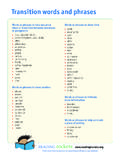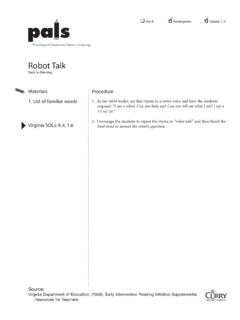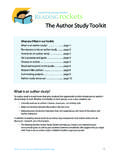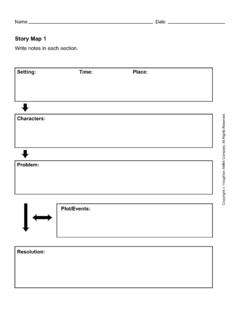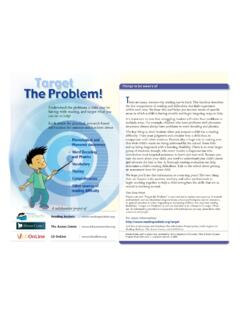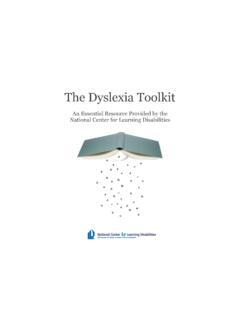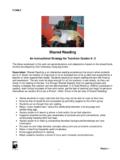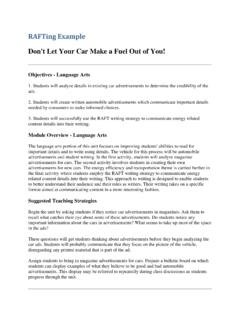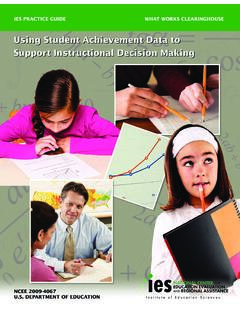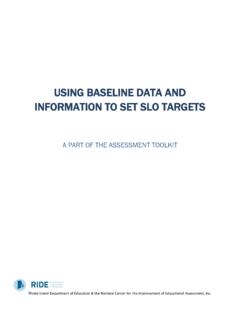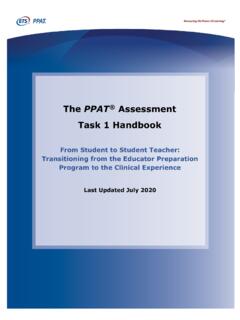Transcription of Structured Literacy and Typical Literacy Practices
1 <sc>Council for Exceptional Children</sc> <sc>TEACHING Exceptional Children</sc>research-article2017 Structured Literacy and Typical Literacy PracticesUnderstanding Differences to Create instructional OpportunitiesLouise Spear-SwerlingStructured LiteracyTEACHING Exceptional Children, Vol. XX, No. X, pp. 1 11. Copyright 2018 The Author(s). DOI: CounCil for ExCEptional ChildrEnIsabelle Rowe is an elementary-level special education teacher who is beginning her second year of teaching. A third grader named Curtis was recently placed on her caseload after being identified with dyslexia at the end of Grade 2. In preparation for working with him, Ms. Rowe read his file. She knew that difficulties with phonemic awareness, decoding, and spelling are central to dyslexia, and as she anticipated, Curtis did have a history of these kinds of problems. As a beginning third grader, Curtis should be able to decode most one-syllable and two-syllable phonetically regular words; he also should be starting to read more complex types of texts, such as chapter books, written at an early-third-grade level.
2 However, assessments in Curtis s file showed that he had difficulty decoding many one-syllable word patterns, such as unfamiliar silent e words ( , tame, stripe), but his ability to read common sight words was relatively good. He also had poor spelling skills, and because he often omitted sounds in words or substituted other sounds that did not belong, Ms. Rowe often could not even recognize the intended word in Curtis s Rowe was not surprised to discover that Curtis had an excellent oral vocabulary and good listening comprehension, because she knew that such strengths are found in many students with dyslexia. However, when she reviewed his history, she was somewhat puzzled to see that Curtis was perceived as doing well in reading as a kindergartner and throughout first grade. He was not identified as needing intervention until the beginning of Grade Rowe s school uses a multitiered-systems-of-support model, with universal screening and tiered interventions as part of the general education system.
3 Unfortunately, although Curtis had received tiered interventions throughout Grade 2, he had not made good progress in those interventions. Because of his inadequate response to tiered interventions, he was referred for a comprehensive evaluation for special education. He was found eligible for services as a student with a learning disability in the area of reading. Although Ms. Rowe had had good preservice preparation with considerable exposure to evidence-based instruction for students with reading difficulties, her experience with specific intervention programs for students with dyslexia was limited. Ms. Rowe was determined to find the details of Curtis s previous interventions, so that she could use that information to help design more effective special education instruction. She also did some reading on evidence-based interventions for students with dyslexia. As part of her research, she repeatedly encountered the term Structured Literacy (SL), so she decided that she needed to find out more about those instructional approaches are often recommended for students with dyslexia and other poor decoders ( , International Dyslexia Association, 2017).
4 These approaches are well supported by research evidence ( , Brady, 2011; Fletcher, Lyon, Fuchs, & Barnes, 2007; Foorman et al., 2016; National Reading Panel, 2000). Examples of SL approaches include the Wilson Reading System (Wilson, 1988), Orton-Gillingham (Gillingham & Stillman, 2014), the Lindamood Phoneme Sequencing Program (Lindamood & Lindamood, 1998), and Direct Instruction ( , Carnine, Silbert, Kame enui, & Tarver, 2009). Although these programs vary in some ways, they all share several key Features of Structured Literacy ApproachesKey features of SL approaches include (a) explicit, systematic, and sequential teaching of Literacy at multiple levels phonemes, letter sound relationships, syllable patterns, morphemes, vocabulary, sentence structure, paragraph structure, and text structure; (b) cumulative practice and ongoing review; (c) a high level of student teacher interaction; (d) the use of carefully chosen examples and nonexamples; (e) decodable text; and (f) prompt, corrective FeaturesExplicit means that important skills and concepts are taught clearly and directly by the teacher; students are not expected to infer them simply from exposure or incidental learning (Archer & Hughes, 2011).
5 Systematic and sequential means that skills and concepts are taught in a logical order, with important prerequisite skills taught first (Torgesen, 2006). For example, before teachers expect students to decode two-syllable words, they teach decoding of common one-syllable word patterns as well as how to divide two-syllable words to facilitate decoding them. The sequential nature of SL means that teachers require students to practice only what they have been explicitly taught. Again, before teachers expect students to practice decoding specific phonics word patterns ( , short-vowel words with consonant digraphs) in reading text, or to recognize specific irregular words in text, they directly teach those skills in isolation first. SL approaches also build in cumulative practice and ongoing review of previously learned skills, so that students retain these skills and develop additional feature of SL, and of explicit teaching approaches in general (Archer & Hughes, 2011), is a high degree of teacher student interaction, with considerable time spent in direct teaching.
6 In these approaches, instruction requires frequent responses from students, and the teacher provides immediate feedback with clear correction as needed. The teacher provides step-by-step demonstrations of skills and leads students in guided practice. Explicit instruction also uses nonexamples as well as examples. For instance, if teachers want students to learn the vowel-r (VR) syllable pattern (words that have a vowel followed by an r, which changes the vowel sound), they present both VR words ( , barn, short, urn) and non-VR words ( , trip, rag, brush) for students to distinguish from each other. Examples and nonexamples would be carefully chosen to ensure that students learn the concept being taught, TEACHING ExCEptional ChildrEn | Mon/Mon 2018 3in this case, that the r in a VR syllable must come immediately after the vowel, not before the early stages of instruction, when students decoding skills are relatively limited, most SL approaches have students read decodable texts, those constrained mostly to the specific phonics patterns that students have been taught ( , consonant-vowel-consonant words with a, i, and o).
7 Just as when students read words in isolation, SL teachers would provide prompt corrective feedback to students decoding errors during oral text reading. Table 1 provides some examples of the kinds of explicit instructional activities that are common in SL for Students with DyslexiaSL is especially well suited to students with dyslexia because it directly addresses their core weaknesses in phonological skills, decoding, and spelling (Moats, 2017). Although most students with dyslexia do not have core weaknesses in higher levels of Literacy , such as vocabulary, text comprehension, and broad language aspects of written expression (Fletcher et al., 2007), their weaknesses in phonological skills, decoding, and spelling often have secondary negative effects on these higher-level areas. For example, inaccurate or nonautomatic decoding may affect students reading comprehension, resulting in poor comprehension of text that students would easily understand if it were read aloud to them.
8 Likewise, poor or effortful spelling can inhibit students ability to translate a strong knowledge base about a topic into their written expression. Explicit teaching of higher levels of Literacy may therefore benefit students with dyslexia (as well as other students) even when they do not have an intrinsic learning problem in those commercial programs exemplify SL and research has generally focused more on effective features of instruction than on comparing specific commercial programs. For example, Kilpatrick (2015) reviewed evidence suggesting that SL programs that emphasize development of phonemic awareness to an advanced level ( , programs that train students to manipulate, delete, and substitute phonemes rather than only to blend and segment phonemes) may be more effective than other SL programs in helping poor decoders attain automatic word recognition. In any case, all SL programs have marked differences from the type of reading instruction that is common in Tier 1 general education instruction and, often, even in tiered interventions (Moats, 2017).
9 In her readings on SL, Ms. Rowe found studies showing that SL interventions clearly improve the reading achievement of students with dyslexia ( , Simos et al., 2002; Torgesen et al., 2001). She also visited a special education class in a neighboring district in which an SL program was being used. Student data showed significant benefits to students reading skills after implementation of the program. Ms. Rowe s reading, as well as her observations of the class, convinced her that SL differed in fundamental ways from the Tier 1 Literacy instruction at her own school. Moreover, even the tiered interventions that Curtis had previously received did not generally use SL activities, such as the ones shown in Table 1 or described in research studies. Although Curtis s tiered interventions had all addressed phonics to some extent, they did so in ways very different from SL. It was evident to Ms.
10 Rowe that continued use of these types of programs was not likely to benefit Curtis. She went to her school principal, Ms. Watkins, and asked to participate in professional development in an SL approach. Ms. Rowe pointed out that this professional development would enable her to help both Curtis and other students in her class more effectively. Luckily, Ms. Watkins had the funds for Ms. Rowe s professional development and approved the Literacy Practices (TLP)Just as the SL approaches described previously vary from each other in some ways, so, too, does the TLP commonly used in schools. Examples of these non-SL Literacy approaches include Guided Reading ( , Burkins & Croft, 2010), Reader s Workshop ( , Calkins, 2000), Balanced Literacy , Four Blocks Literacy (Cunningham, Hall, & Sigmon, 1999), Reading Recovery (Clay, 1994), and the Leveled Literacy Intervention (Fountas & Pinnell, 2009).

